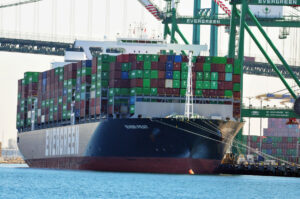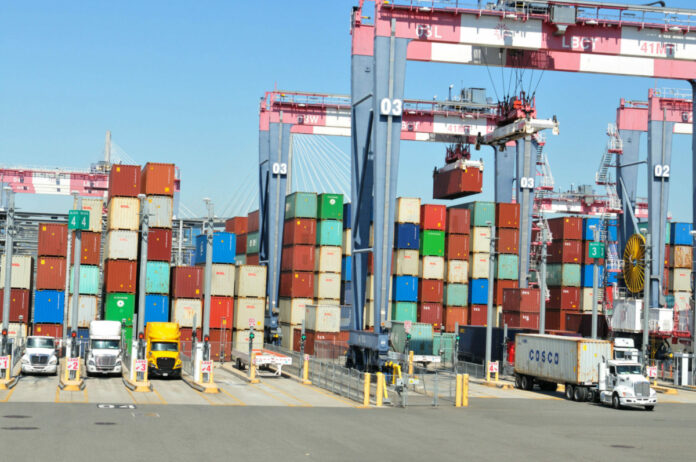San Pedro Bay ports of Los Angeles and Long Beach have seen historic growth during the past decade as they work to bolster infrastructure and environmental sustainability.
In May, the Port of Los Angeles, based in San Pedro, recorded its third-best overall month in its 115-year history, processing 967,900 Twenty-Foot Equivalent Units (TEUs). That number is up from 731,353 TEUs a decade ago in May 2012.
A TEU is a unit of cargo capacity used for container ships and ports based on the volume of a 20-foot-long metal box that can be transferred between different transports, such as ships, trains and trucks.
In the first five months of 2022, the Port of Los Angeles processed more than 4.5 million TEUs, equal to last year’s record-setting pace.
“Retailers replenished inventory throughout the spring and now we’ll see a transition to back-to-school goods, fall fashion and some early year-end holiday products,” said Gene Seroka, executive director at the Port of Los Angeles. “While American consumers have become more cost conscious, overall demand remains strong.
Retailers replenished inventory throughout the spring.
Gene Seroka
Port of Los Angeles
In 2021, the port facilitated $294 billion in trade and handled a total of 10.7 million container units, the busiest calendar year ever for the port.
The Port of Long Beach saw a similar surge in activity during the last decade, with total TEUs hitting 890,989 this May, up from 497,892 TEUs in the same month in 2012.
Covid dips
The Port of Los Angeles saw a significant dip in activity during the first year of the pandemic, dipping to 581,664 TEUs during May 2020, compared to 828,662 at the same time a year earlier. According to port representatives, the drop was caused in large part by canceled sailings due to the pandemic, a trade conflict with China, and shifts in liner services.
However, in May 2021, the Los Angeles Port experienced the busiest month in its history, handling more than 1 million TEUs, a first ever for a port in the Western Hemisphere. That milestone was preceded by 10 consecutive months of year-over-year increases.
“The historic level of cargo that we’re managing reflects our commitment to reach new heights by working with our partners to further enhance our productivity, throughput and velocity,” said Seroka at the time. “Much credit goes to our longshore workforce, truckers, terminal operators, ocean carriers, railroads and other stakeholders for scaling up to meet this extraordinary demand.”
The Port of Long Beach’s TEU numbers didn’t drop as drastically in 2020 as did the Port of Los Angeles’, but Long Beach also saw a surge in TEU numbers in 2021.

Port budgets
Last month, the Los Angeles Board of Harbor Commissioners adopted a $1.9 billion budget for the next fiscal year. Pandemic-induced consumer buying is expected to wane in the coming fiscal year, therefore the budget is based on cargo volume estimates of approximately 9.85 million TEUs.
The budget forecasts operating revenues of $628.1 million, including $439.7 million from shipping revenues, $47.4 million from the Clean Truck Fund, and the remainder from rentals, royalties and fees, and other operating revenue categories. Operating expenses are expected to hit $334 million. The port’s Capital Improvement Program for the year includes $180.5 million for terminal, transportation, security and public access projects.
“This forward-thinking budget positions the port well to meet its overall strategic objectives and priorities, and keep our ranking as the premier container port in the Western Hemisphere,” said Seroka.
With increased traffic at both San Pedro Bay ports comes concern with the burden that transportation emissions place on the atmosphere. However, since 2005, port-related emissions in San Pedro Bay have dropped 90% for diesel particulate matter, 63% for nitrogen oxides and 97% for sulfur oxides. The local ports plan to reduce greenhouse gases to 40% below 1990 levels by 2030 and 80% below 1990 levels by 2050.
In October, the ports of Long Beach and Los Angeles announced a temporary policy that charges ocean carriers for each import container dwelling nine days or more at a terminal. The program, which is being called the “Container Dwell Fee,” does not have a set start date.
The eventual plan is to charge ocean carriers $100 per container, increasing in $100 increments per container per day until the container leaves the terminal. Fees collected from dwelling cargo will be reinvested in programs to enhance port efficiency, accelerate cargo velocity and address congestion impacts.
The two ports have already seen a combined decline of 38% in aging cargo on the docks.



